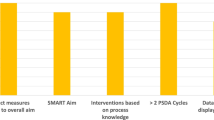Abstract
BACKGROUND
Residency programs involve trainees in quality improvement (QI) projects to evaluate competency in systems-based practice and practice-based learning and improvement. Valid approaches to assess QI proposals are lacking.
OBJECTIVE
We developed an instrument for assessing resident QI proposals—the Quality Improvement Proposal Assessment Tool (QIPAT-7)—and determined its validity and reliability.
DESIGN
QIPAT-7 content was initially obtained from a national panel of QI experts. Through an iterative process, the instrument was refined, pilot-tested, and revised.
PARTICIPANTS
Seven raters used the instrument to assess 45 resident QI proposals.
MEASUREMENTS
Principal factor analysis was used to explore the dimensionality of instrument scores. Cronbach’s alpha and intraclass correlations were calculated to determine internal consistency and interrater reliability, respectively.
RESULTS
QIPAT-7 items comprised a single factor (eigenvalue = 3.4) suggesting a single assessment dimension. Interrater reliability for each item (range 0.79 to 0.93) and internal consistency reliability among the items (Cronbach’s alpha = 0.87) were high.
CONCLUSIONS
This method for assessing resident physician QI proposals is supported by content and internal structure validity evidence. QIPAT-7 is a useful tool for assessing resident QI proposals. Future research should determine the reliability of QIPAT-7 scores in other residency and fellowship training programs. Correlations should also be made between assessment scores and criteria for QI proposal success such as implementation of QI proposals, resident scholarly productivity, and improved patient outcomes.

Similar content being viewed by others
References
ACGME Outcome Project. Available at: http://www.acgme.org/outcome/comp/compFull.asp. Accessed July 29, 2006.
Ashton CM. “Invisible” doctors: making a case for involving medical residents in hospital quality improvement programs. Acad Med. 1993;68(11):823–4.
Headrick LA, Richardson A, Priebe GP. Continuous improvement learning for residents. Pediatrics. 1998;101(4 Pt 2):768–73; discussion 773–4.
Parenti CM, Lederle FA, Impola CL, Peterson LR. Reduction of unnecessary intravenous catheter use. Internal medicine house staff participate in a successful quality improvement project. Arch Intern Med. 1994;154(16):1829–32.
Frey K, Edwards F, Altman K, Spahr N, Gorman RS. The ‘Collaborative Care’ curriculum: an educational model addressing key ACGME core competencies in primary care residency training [see comment]. Med Educ. 2003;37(9):786–9.
Amin AN, Rucker L. A systems-based practice curriculum. Med Educ. 2004;38(5):568–9.
Djuricich AM, Ciccarelli M, Swigonski NL. A continuous quality improvement curriculum for residents: addressing core competency, improving systems. Acad Med. 2004;79(10 Suppl):S65–7.
Ogrinc G, Headrick LA, Morrison LJ, Foster T. Teaching and assessing resident competence in practice-based learning and improvement. J Gen Intern Med. 2004;19(5 Pt 2):496–500.
Ziegelstein RC, Fiebach NH. “The mirror” and “the village”: a new method for teaching practice-based learning and improvement and systems-based practice. Acad Med. 2004;79(1):83–8.
Allen E, Zerzan J, Choo C, Shenson D, Saha S. Teaching systems-based practice to residents by using independent study projects. Acad Med. 2005;80(2):125–8.
ACT (Achieving Competence Today) Online. Available at: http://www.actcurriculum.org/. Accessed June 27, 2006.
Langley GJ, Nolan KM, Nolan TW, Norman CL, Provost LP. The Improvement Guide: A Practical Approach to Enhancing Organizational Performance. San Francisco, CA: Jossey-Bass; 1996.
Cleghorn GD, Headrick LA. The PDSA cycle at the core of learning in health professions education. Joint Comm J Qual Improv. 1996;22(3):206–12.
Berwick DM, Nolan TW. Physicians as leaders in improving health care: a new series in Annals of Internal Medicine [see comment]. Ann Intern Med. 1998;128(4):289–92.
DeVellis RF. Scale Development: Theory and Applications. London: Sage Publications; 1991.
Gorsuch RL. Factor Analysis, Second Edition. Hillsdale: Lawrence Erlbaum Associates, Inc.; 1983.
Landis JR, Koch GG. The measure of observer agreement for categorical data. Biometrics. 1977;33:159–74.
Swing SR. Assessing the ACGME general competencies: general considerations and assessment methods. Acad Emerg Med. 2002;9(11):1278–88.
Lynch DC, Swing SR, Horowitz SD, Holt K, Messer JV. Assessing practice-based learning and improvement. Teach Learn Med. 2004;16(1):85–92.
Messick S. Validity. In: Linn RL, ed. Educational Measurement. 3rd ed. Phoenix, AZ: Oryx Press; 1993.
Downing SM. Validity: on the meaningful interpretation of assessment data. Med Educ. 2003;37:830–7.
Standards for Educational and Psychological Testing. Washington, DC: American Education Research Association; 1999.
Cook DA, Beckman TJ. Current concepts in validity and reliability for psychometric instruments: theory and application. Am J Med. 2006;119:166e7–16.
Beckman TJ, Ghosh AK, Cook DA, Erwin PJ, Mandrekar JN. How reliable are assessments of clinical teaching? A review of the published instruments. J Gen Intern Med. 2004;19:971–7.
Beckman TJ, Cook DA, Mandrekar JN. What is the validity evidence for assessments of clinical teaching? J Gen Intern Med. 2005;20:1159–64.
Moss F, Thompson R. A new structure for quality improvement reports [comment]. Qual Health Care. 1999;8(2):76.
Davidoff F, Batalden P. Toward stronger evidence on quality improvement. Draft publication guidelines: the beginning of a consensus project [see comment]. Qual Saf Health Care. 2005;14(5):319–25.
Acknowledgments
We are grateful to Gordon T. Moore, M.D., M.P.H, Maryjoan Ladden, Ph.D., R.N., C.S., Antoinette Peters, Ph.D., and the faculty of the other academic medical centers involved in the Achieving Competency Today initiative for their input at the original forum discussing content that formed the basis for the first iteration of QIPAT-7. We also extend our thanks to Mr. Gregory J. Engstler and Ms. Pamela J. Nelson for their technical assistance with the computerized version of the assessment tool.
There were no external or internal funding sources for this work.
Conflict of Interest
None of the authors has any conflict of interest related to this work.
Author information
Authors and Affiliations
Corresponding author
Rights and permissions
About this article
Cite this article
Leenstra, J.L., Beckman, T.J., Reed, D.A. et al. Validation of a Method for Assessing Resident Physicians’ Quality Improvement Proposals. J GEN INTERN MED 22, 1330–1334 (2007). https://doi.org/10.1007/s11606-007-0260-y
Received:
Revised:
Accepted:
Published:
Issue Date:
DOI: https://doi.org/10.1007/s11606-007-0260-y




